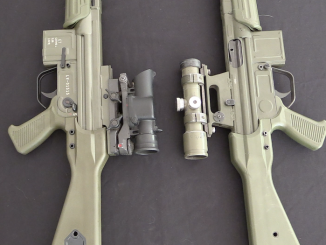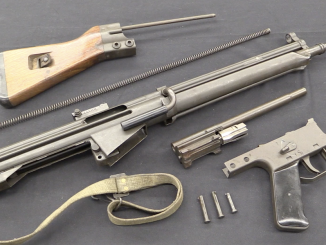Beistigui Hermanos is probably the least known of the Spanish machine pistol manufacturers, despite being the first to actually make such pistols. Beistigui was founded in 1910 in Eibar, and was one of the initial subcontractors chosen to make Ruby pistols for the French military during World War One. The discovered a substantial market for C96 Broomhandle type pistols in China during the 1920s, and introduced their own similar looking pistol in 1926 – the Model H.
This pistol was popular, but Beistigui realized that a fully automatic version would probably be much more desirable – and they were right. They introduced such a machine pistol in 1927 or 1928, and sold 22,000 of them in China by the end of 1929. These early pistol still used the same 10-round fixed magazine as the Mauser C96, however, and were seriously limited in practicality as a result.
In 1930, Beistigui introduced an improved version of the gun as the MM31 – the Modelo Military 1931. Despite being a C96 Mauser lookalike (and deliberately trying to make Chinese customers confuse it with actual Mausers), it was a legitimately very good gun, and included a number of improvements over the Mauser. A 20-round fixed magazine version was quickly introduced, followed by a detachable magazine version, to address the issues inherent to a gun with a 10-round magazine and a 900 round/minute rate of fire. Shortly after Beistigui introduced they detachable magazine gun, Mauser began to sell the Schnellfeuer. In an excellent marketing decision, Beistigui changed their guns to use copies of the Mauser magazine, allowing interchangeability with the most respected and desirable model of the pistol in China. The gun we are looking at today is one of these last pattern MM31 machine pistols, using Mauser magazines.
By the mid 1930s, the market for these guns had pretty much collapsed. In Spain, the abdication of the king in 1931 and growing civil unrest led to much increased government regulation of arms manufacture and the Japanese invasion of China limited the ability of Japanese traders to bring the guns to Chinese markets. Beistigui made one last unsuccessful effort to market a Broomhandle type gun (the MM34) to the Spanish Guardia Civil, and then transitioned to manufacturing bicycles instead of guns.




“They introduced such a machine pistol in 1927 or 1928”
In similar time, F.V.Tokarev, created their 7,62×25 machine pistols:
https://pikabu.ru/story/avtomaticheskie_pistoletyi_tokareva_4424826
1st photo from top:
TOP: 7,62-mm machine pistol by Tokarev, big
LEFT BOTTOM: 7,62-mm machine pistol by Tokarev, small
RIGHT BOTTOM: F.V.Tokarev
2nd and 3rd photo from top: “small” machine pistol
4th and 5th photo from top: “big” machine pistol
In late 1920s Артиллерийский комитет ГАУ created requirements for pistol for РККА. 7,65×17 Browning (.32 Auto) was considered, but abandoned as it was deemed too weak. Finally 7,63×25 Mauser was chosen, already used in Red Army. License and machinery was bought from DWM. It was adopted as 7,62-мм пистолетный патрон обр. 1930г.. But even before that there was work on new weapon for it. After gathering of Реввоенсовет (22 May 1929) it was decided that there should be 2 maximally unified pistols: “small” with 9-round magazine and mass 500-600 g; “big” with 20-25 rounds and mass no more than 2,5 kg. One of competitors was F.V.Tokarev, his “small” and “big” machine pistols differs mainly in size (cf. photo). They have following features:
-fixed barrel and blow-back operation
-single action with exposed hammer
-fire mode selector on left side
-22 round magazine inside grip (note peculiar shape of grip), detachable
-hold-open device
-can be also loaded using Mauser C96 strippers, from top
-length and mass with empty magazine (“big”): 465 mm; 2225 g
-length and mass with empty magazine (“small”): 310 mm; 1668 g
-“big” has forward wooden furniture and ability to attach stock (see photos)
Both were turned down, as have unsatisfactory reliability and high Rate-of-Fire of 1000 rpm, fast depleting magazine.
These Tokarev machine pistols are now in Military Historical Museum of Artillery, Engineers and Signal Corps in Saint Petersburg (BTW: this is one of oldest Russian military museum as it was created by decision of Peter Great from 1702.
http://www.artillery-museum.ru/en/home.html
It would be interesting to know how the gun arrived to the US.
The date and EPV letters could be reference to post-Spanish-Civil-War “maquis”.
Their weapons were rarely brand new military weapons (could get a few during WWII, and STENs are often seen in pictures), being more often than not civilian or Civil War era guns. Also, 1947 was the high point of their war against the Franco government, plus EPV could stand for “Ejército Popular de V…?” or some political slogan of the era (or just the guy’s initials, of course).
So, an interesting piece that probably has an interesting history behind.
Thank you Jose Antonio Garcia. I knew something of the last Spanish Civil War but the “maquis” was a complete surprise! And reading about how significant their actions against the Nazis in France were was even more of a surprise.
You’re welcome.
It’s probably the less known part of our Civil War, probably due to propaganda and media control during the dictatorship (what I find surprising is that modern politicians still using the period as justification for their actions rarely, if ever, mention the maquis, despite many of them having been mythified in the early years of the democracy).
The maquis movement lasted quite a few years, but since the western world considered the Soviet Union a bigger danger than a second rate dictator, they didn’t get much support from a Europe rebuilding from WWII.
Also, despite some of the maquis groups were comunists, at least until the late 40’s, they weren’t enough to get support from the Soviets either, unlike what happenned in the Greek Civil war in the same years. But according to some (government propaganda?) were directed from Moscow.
But most were just scattered small bands, people trying to survive in the mountains, or in small towns, and not getting arrested or worse.
And since most of the groups refused to work with others (as in the civil war, anarchists hated communists, who hated socialists, who…), plus frictions between urban and rural groups, so they probably were their own worst enemy.
The Chinese sure had an insatiable addiction with the broomhandles. I wonder how many might still be found over there, lovingly stashed away. And how many made the journey to Formosa (now Taiwan) hidden in the luggage of Chinese exiles.
I bet you’ll find LOTS of stuff that hasn’t been discovered by the authorities. If regular rice-farming people were capable of hiding their guns from the Imperial Japanese Army, they could keep those same guns safe from getting confiscated by simply doing what Germany did. They likely handed over broken guns and hid the good ones where nobody would actually look.
i dont know nearly as much about broom handle mausers and the clones as i would like.
The Spanish bicycle industry owes a great deal to the Spanish gun industry since Orbea also started as a gun maker. The Basque country is still producing great bicycle racers despite the demise of the iconic Euskatel Euskadi pro team.
It´s Beistegui Hermanos, not Bestigui.
The present time BH Bicycles are from the same lineage.
I know because I am Basque. I had a Beistegui fellow pupil at school back in the 1980s, near Vitoria. His family related to BH.
Greetings from the basque country and many thanks for this great-great site.
Here you have the history of BH:
https://www.bhbikesusa.com/107-years-of-bh
The shield with the “X” inside is the Eibar proof mark, currently still in use. I own two old rifles (a Swiss K11 and an Spanish Mauser) and both are marked “BOPE” plus the “X” shield, meaning that the old (and therefore out of modern regulations) guns have been proofed with a test cartridge at the BOPE in Eibar:
https://www.google.es/search?client=firefox-b-ab&dcr=0&q=bope+eibar&oq=bope+eibar&gs_l=psy-ab.3..0l2j38.13731.13731.0.14665.1.1.0.0.0.0.95.95.1.1.0….0…1.1.64.psy-ab..0.1.95….0.lbaCi2mKAAk
The BOPE wae created precisely because proofing was required if you wanted to export guns. Ironically guns produced for the Spanish market had no proof markings, because the laws for the Spanish market were very lax.
If a gun enters in the European Union via Bilbao, by law it is proofed at the BOPE. Even my (made in Conneticut, USA) .22 carbine Marlin 795 has the Eibar “X” crest.
Neither of my two MM31 had the detachable magazine, but they still featured the millout on the sides of the receiver. The grips were originally with straight lines. The shoulder stocks originally were not serialized at all, which would indicate the shoulder stock from the auction originates from a Mauser C96.
Many of them were made for the French Police too, so they do appear from time to time in Europe.
While my early pistol (2x.xxx block) still has a very lightly carved MM31 designation on it, the later one didn’t have this any more. The “PMP” marking on the opposite side however remains a mystery to me and I’d highly appreciate any thoughts on this.
[IMG]http://i251.photobucket.com/albums/gg296/DaveFromSheffield/Guns/MM31/royal_07.jpg[/IMG]
[IMG]http://i251.photobucket.com/albums/gg296/DaveFromSheffield/Guns/MM31/royal10.jpg[/IMG]
[IMG]http://i251.photobucket.com/albums/gg296/DaveFromSheffield/Guns/MM31/royal_08.jpg[/IMG]
The Guardia Civil (gendarmerie) adopted a variant of the Astra 903 machine pistol in 9 mm largo, the Astra Model F, which won the competition against the Beistegui Hnos. MM34.
Elite intervention units of Spanish police (Cuerpo de Seguridad y Asalto) were also issued with Astra machine pistol but in 7.63 mm, the Astra 901 (10 rounds magazine) and Astra 902 (20 rounds magazine).
In this matter, I can tell you a lot about what. For ten years I have been interested in weapons from different times. I have written extensively about leadership, using https://studydriver.com/leadership/ for this. For me, the top is the submachine gun (M712 Schnellfeuer) Mauser C96. I compared models a lot and I can say that he is the best.